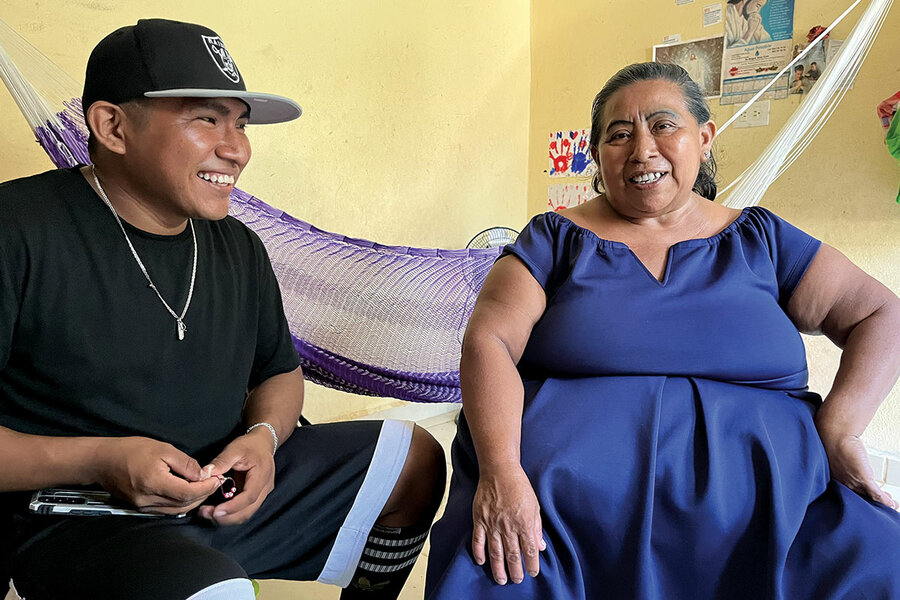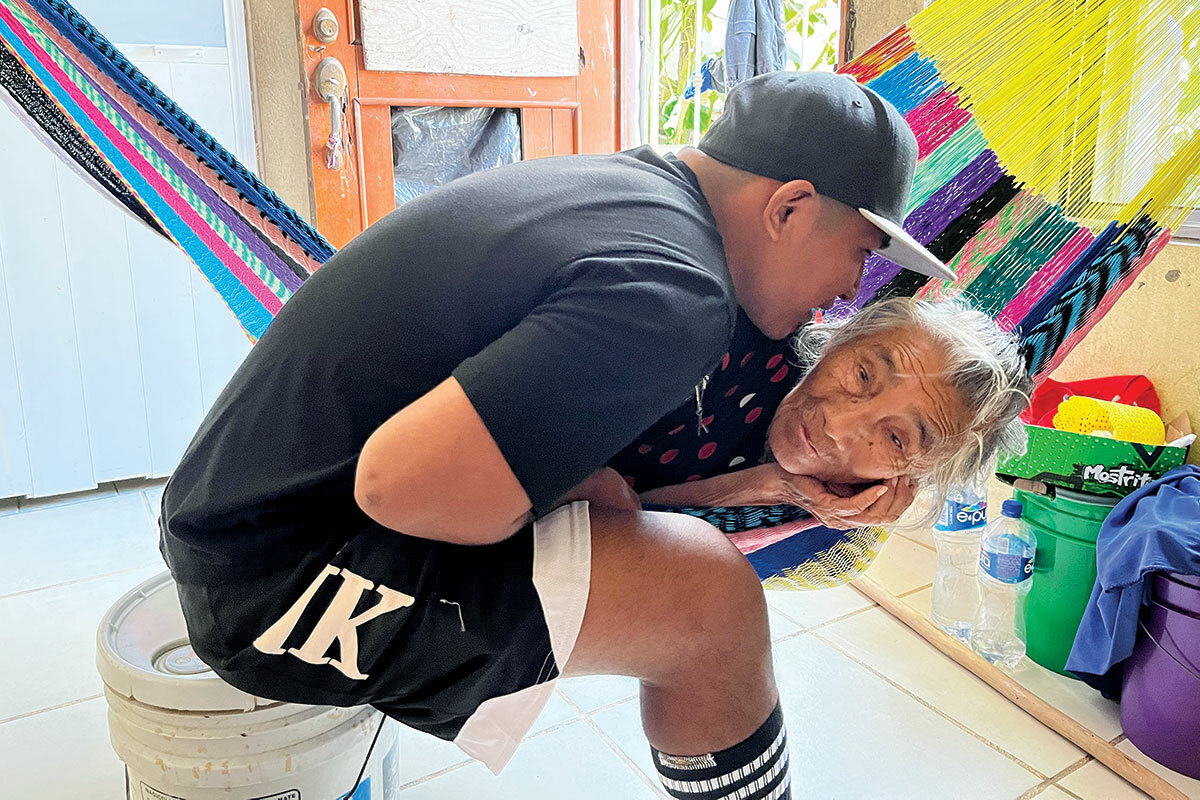Preserving culture: Rappers keep the Maya language alive
Loading...
| Tulum, Mexico
Angel del Rosario Hau Paat leans over the rainbow-colored hammock where his grandmother lies and speaks directly into her ear: “What do you think of my singing?” he shouts in Maya, the Indigenous language of Mexico’s Yucatan.
Hard of hearing, she strokes his face as she responds. “She’s happy,” he translates, with a bashful laugh. “She says my Maya is good.”
Growing up in the southern Mexican state of Quintana Roo, Mr. del Rosario says he wasn’t interested in learning Maya, the only language his grandmother speaks and which his mother grew up speaking. Spanish is what was useful for him at school and among friends.
Why We Wrote This
A story focused onFor some young people in Mexico, rapping in Maya offers more than self-expression. It also presents a path to cultural preservation.
But today he is part of a growing trend among young people – here and across the Americas, from Canada to Chile – who are rapping in Indigenous languages. It’s strengthened his connection to the language his mother raised him speaking (and to which he grew up responding in Spanish) and to his family’s traditions.
“I never imagined myself using Maya so much. I’m making more connections with my culture and with people from other countries also rapping in Indigenous languages,” says Mr. del Rosario, a pool technician in the resort town of Tulum who records music under the name ADR Maya in his free time. “It feels really good.”
Mexico is home to more than 60 officially recognized Indigenous languages. Many of them, and their associated cultures, are at risk – despite a 2002 law protecting the right to use one’s Indigenous language and education reforms in recent years that require some languages be taught in public schools.
At least 40% of the world’s Indigenous languages are also in danger of disappearing, according to the United Nations. But, for young artists like Mr. del Rosario, the discovery of rap in Maya is serving as a motivation to double down on learning more.
“Despite the rhetoric around protecting Mexican culture, there is a lot of pressure put on [Indigenous] communities to give up their languages” for Spanish, says José Antonio Flores Farfán, a professor of linguistics and anthropology at the Center for Research and Higher Studies in Social Anthropology in Mexico City.
“Treasures that human beings have accumulated for centuries are encrypted in language,” he says of the importance of their perseverance.
“It’s these kids, these rappers, these artists who give me hope” for the future of Indigenous languages, Dr. Farfán says, emphasizing that to be successful, the desire to keep a language in use must come from the community itself. “They are talented, doing something about it from the bottom up, and they’re inspiring younger kids and new generations to see value in the language in the process.”
“What do your songs say?”
In the Yucatec-Maya-speaking region of southern Mexico, Jesús Cristobal Pat Chablé, more popularly known as “Pat Boy,” could be considered the Johnny Appleseed of Indigenous rap. The artist, in his early 30s, started playing music when he was 5 years old and experimented with different genres, from rancheras (Mexican ballads) to rock to reggae, launching his solo rap career in 2009.
Today, he travels internationally, rapping in Maya; collaborates with artists who speak other Indigenous languages; and encourages young Maya speakers to write and record their own music, some of which ends up on albums he produces through his label ADN Maya. He’s currently building a recording studio in the town of Felipe Carrillo Puerto, about 140 miles south of Cancun.
Themes of daily life in Maya communities – customs, education, love, and traditions – populate his lyrics. His efforts have won him international recognition, including the 2022 Linguapax Award. Last year, a song Pat Boy collaborated in writing and singing was featured on the “Wakanda Forever” soundtrack, bringing the Maya language to theaters around the world with lyrics like: “They say we disappeared from this earth, what do you think? / It isn’t true ... years passed, we became stronger. / Today I treasure the Mayan culture.”
It’s a far cry from how he started.
“It was tough. I’d try to get a spot in a public festival and people would say, ‘But what do your songs say?’” he recalls of his early years performing in Quintana Roo. “I was in my right to speak and sing in my maternal language, but there was this fear [among organizers] that I was motivating people to do things against the government, to rise up, because it was written in Maya and they didn’t understand the words,” he says.
“People in the city say, ‘You can’t achieve things if you’re Maya, you come from the countryside. You can’t be an artist or a painter or a writer,’” he says. “When I started there wasn’t a lot of interest in what I was doing. Now, everywhere I go I meet young people dreaming of singing in Maya.”
Maria Marlene Ucan, who raps under the name “Ixi’im Ko’olel” (“Mujer Maiz,” or Corn Woman), remembers the day Pat Boy came to present his music at her public high school in Yucatan state five years ago. She was so inspired to hear Maya used in rap that she went home and started looking for his work online, memorizing lyrics and then writing her own.
In August 2022, she submitted a song she’d penned to Pat Boy, which he selected to appear on his fourth album made up of original songs written and performed by young Mayan artists, expected to be released later this year.
“I always put such a priority on learning Spanish. I didn’t understand the importance of our language,” says Ms. Ucan, who works in a grocery store bakery and credits time spent with her grandparents growing up with her comfort in speaking Maya. “I felt I could go further with Spanish and sometimes felt a little embarrassed that my family spoke Maya.”
Today, she writes songs about what it’s like to be an Indigenous woman in Mexico. Traveling to record with Pat Boy was an eye-opening experience: She had never ventured far from home, and while recording, she was mostly surrounded by young male artists. It was a social situation she had never found herself in before, having grown up in a small, conservative community.
“I feel a difference when I’m expressing myself in Maya versus Spanish,” she says, explaining that the romance language feels more repetitive in its vocabulary and structure. “In Maya, I end up finding new words, little twists I can put into my verses. It’s more playful.”
It also takes longer – she has to search her memory for vocabulary or ask her parents to fill in gaps. But music has sparked a new dream for her: studying Maya at the university level next year.
“Our language will live on”
This generation of youth – many of whom grew up exposed to Maya but never gained fluency – will be a big test for the language’s preservation, says Marlene Chuc Maldonado, head of the department of language and intercultural studies at the Mayan Intercultural University of Quintana Roo.
She says she’s found inspiration in “what’s going on with rap,” in many communities here. “There are rap battles and all these groups arrive and perform in public squares. It really piques the interest of the young,” she says.
That’s important “but, we need to see if these teens and young adults who are rapping now or listening to this music, if they become parents, will they teach their kids the language?” Ms. Chuc asks. “If their parents already didn’t teach them and they learned from their grandparents or for the love of music, their decisions will be critical” for what happens with Maya next.
Back in Tulum, Filiberta Paat Mas, Mr. del Rosario’s mother, sits in a corner of her creamsicle-yellow home. She watches wide-eyed as her son raps lyrics written on his cellphone about Chaac, the Mayan god of rain. He’s not fluent in Maya, they both agree, but he’s making progress.
“When I die, he’ll still speak Maya,” she says, a tinge of surprise in her voice as she describes the sense of failure she felt all those years when he insisted on only speaking Spanish.
“He’ll teach it to his children,” she says. “Our language will live on.”








